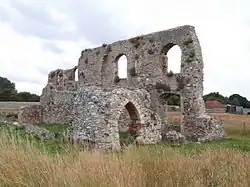Greyfriars, Dunwich
Greyfriars, Dunwich was a Franciscan friary in Dunwich in the English county of Suffolk. The friary was founded before 1277 by Richard FitzJohn and his wife Alice and dissolved in 1538.[1] The original site, which had 20 friars in 1277 when it first appears in records, was threatened by coastal erosion and the friary was moved inland in 1289.[1]
 Remains of Greyfriars Priory south range buildings, probably the refectory | |
 Location within Suffolk | |
| Monastery information | |
|---|---|
| Order | Franciscan |
| Established | Before 1277 |
| Disestablished | 1538 |
| People | |
| Founder(s) | Richard FitzJohn and Alice |
| Architecture | |
| Status | Ruins |
| Heritage designation | Grade II* listed building, Scheduled Monument |
| Site | |
| Location | Dunwich, Suffolk, England |
| Country | England |
| Coordinates | 52.2755°N 1.6307°E |
| Public access | Yes |
| Website | Dunwich Greyfriars Trust |
Many of the buildings are believed to have been destroyed on dissolution, with the remains used as a house, a town hall and a jail at various times. Modern remains consist of a precinct wall, two gatehouses and some two-storey walls believed to be the remains of a cloister building, possibly a refectory or infirmary building.[1][2]

The site was partly excavated in the 1930s and 1990s, with geophysical surveys being carried out on the site.[2] The site was surveyed in 2011 as part of a dig by archaeological television programme Time Team. A geophysical survey using ground-penetrating radar confirmed a range of wall features and other anomalies in the precinct[3] and trenches uncovered carved medieval stonework and medieval window glass fragments.[2][4] Geophysical surveys suggest that the friary church may have been up to 60 metres in length.[2]
Some restoration work was carried out in 2008, including the strengthening of some buildings and repair of collapsed section of the precinct wall.[5] The site was then placed on the Heritage at Risk Register,[6] leading to a £250,000 restoration project in 2012 by English Heritage and Suffolk County Council.[7][8] The management of the site was taken over by a local voluntary group, the Dunwich Greyfriars Trust, in October 2013.[8][9] The transfer occurred after budget cuts by the county council meant that the running costs would no longer be met by the council.[7][8][10] The remains are classified as a Grade II* listed building and most of the site as a Scheduled Monument.[11][12]
See also
References
- Historic England. "Dunwich Greyfriars (392095)". Research records (formerly PastScape). Retrieved 23 February 2014.
- Dunwich, Suffolk - archaeological evaluation and assessment of results, Wessex Archaeology, May 2012. Retrieved 2014-02-23.
- Greyfriars, Dunwich Museum. Retrieved 2014-02-23.
- Dig report: Dunwich, Time Team, Channel 4. Retrieved 2014-02-23.
- Priory in 'lost' town is restored, BBC news website, 2008-12-03. Retrieved 2014-02-24.
- Heritage at Risk Register 2011 - East of England, English Heritage, 2011. Retrieved 2014-02-24.
- Ruins in Dunwich and Clare given £400,000 for restoration, BBC news website, 2012-07-30. Retrieved 2014-02-23.
- Dunwich Greyfriars site taken over by charitable trust, BBC news website, 2013-10-29. Retrieved 2014-02-23.
- New future for Dunwich Greyfriars Archived 2014-02-23 at archive.today, Suffolk County Council, 2013-10-29. Retrieved 2014-02-23.
- Suffolk County Council plans to cut country parks, BBC news website, 2011-02-15. Retrieved 2014-02-23.
- Remains of Grey Friars Monastery, Dunwich, British Listed Buildings. Retrieved 2014-02-23.
- Historic England. "Grey Friars (1006039)". National Heritage List for England. Retrieved 23 February 2014.